Introduction
Nuclear power is a topic that often stirs up intense debates and mixed emotions. Some view it as a promising, clean energy source, while others raise concerns about safety and long-term environmental consequences. To make informed decisions about nuclear power, it’s essential to understand the science behind it and the potential benefits it can offer. In this blog post, we’ll explore the mechanisms of power and delve into its advantages.
The Basics of Nuclear Power
What is Nuclear Power?
It is a method of generating electricity through the use of reactions. These reactions release an enormous amount of energy, which is then converted into electricity. The two most common nuclear processes employed in power generation are nuclear fission and nuclear fusion.
- Nuclear Fission: This is the process where the nucleus of an atom, typically uranium-235 or plutonium-239, splits into two smaller nuclei, releasing energy. This is the process used in most nuclear power plants today.
- Nuclear Fusion: Fusion is the process in which two light atomic nuclei combine to form a heavier nucleus, releasing a tremendous amount of energy. While fusion is the process that powers the sun, it has yet to be harnessed for electricity generation on Earth.
How Does Work?
The fission process used in power plants involves a chain reaction. Here’s a simplified explanation of how it works:
- Fuel Rods: It power plants use fuel rods containing uranium fuel. When a neutron collides with the nucleus of a uranium atom, it causes the nucleus to split into two smaller nuclei, releasing more neutrons in the process.
- Control Rods: Control rods made of materials that absorb neutrons are inserted among the fuel rods. These control rods can be raised or lowered to regulate the rate of the chain reaction. Lowering them increases the number of neutron collisions and the heat produced, while raising them slows the reaction down.
- Heat Generation: As the uranium nuclei split, a substantial amount of heat is generated. This heat is used to produce steam from water in a heat exchanger.
- Electricity Generation: The steam generated drives a turbine connected to a generator, producing electricity.
Benefits
Understanding the mechanisms of nuclear power helps us appreciate the potential benefits it offers:
- Low Greenhouse Gas Emissions: Its generates electricity with minimal greenhouse gas emissions. This makes it a valuable tool for reducing the carbon footprint in the fight against climate change.
- Reliable and Stable Energy Supply: Its plants can operate continuously, providing a stable energy supply. They are not dependent on weather conditions, like solar or wind power.
- High Energy Density: Nuclear fuel contains an incredibly high energy density. A small amount of nuclear fuel can produce a significant amount of energy, making it efficient and cost-effective in the long run.
- Long Fuel Supply: Uranium, the primary fuel for nuclear power, is relatively abundant and widely available, ensuring a stable fuel supply for the foreseeable future.
- Decentralized Power Generation: Nuclear can be generated in different regions, reducing the dependence on centralized energy sources.
Conclusion
Exploring the science behind nuclear power reveals a fascinating process with the potential to provide clean, reliable, and efficient energy. While safety concerns must be addressed, understanding the benefits of nuclear power can help us make informed decisions about its role in our energy future. Balancing the advantages of low emissions and energy reliability with safety and waste management challenges is the key to unlocking the full potential of nuclear power in our quest for a sustainable energy future.





